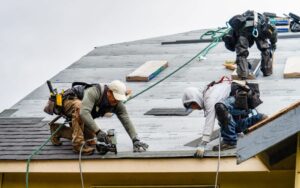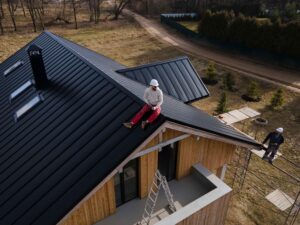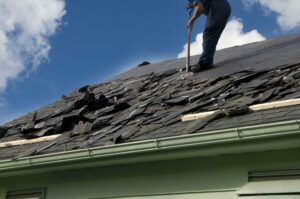Checking if your roof is in good condition is essential for maintaining your home’s integrity. Start with a thorough visual inspection from the ground, looking for any missing shingles or sagging areas. Use binoculars for those hard-to-reach spots. Don’t forget to examine your gutters and flashing for any signs of wear. If you spot anything unusual, it may be time to reflect on a more detailed evaluation. Understanding what to look for can save you from costly repairs later.
Why Roof Inspections Matter
While you might not think about your roof often, regular roof inspections are crucial for maintaining its integrity and safeguarding your home. The average cost of a roof inspection ranges from $120 to $600, depending on factors like roof size, type, and pitch. Basic visual inspections assess visible damage, while advanced methods, such as infrared and drone inspections, provide deeper insights into hidden issues. These evaluations not only identify current problems but also help prevent minor issues from escalating into costly repairs. Detailed reports outline findings and offer repair recommendations, ensuring that you understand the condition of your roof. Regular inspections promote longevity and enhance your home’s value, making them a critical part of responsible homeownership.
Signs Your Roof Is in Good Condition
A well-maintained roof often exhibits several key signs that indicate its good condition. First, check for missing or damaged shingles; intact shingles should lie flat and show no curling or discoloration. Look for clean gutters, as debris can indicate neglect. Inspect flashing around chimneys and vents; it should be securely attached and free from rust or deterioration. Additionally, verify there are no visible leaks or water stains on ceilings inside your home. Finally, a roof without sagging or uneven areas suggests structural integrity. Regular inspections help identify any issues early, allowing you to maintain your roof’s health and longevity, ultimately saving you from costly repairs down the line.
How to Perform a Basic Roof Check Yourself
Performing a basic roof check yourself can be both straightforward and essential for maintaining your home’s integrity. Start by inspecting your roof from the ground, looking for missing or damaged shingles, sagging areas, and debris accumulation. Use binoculars for a closer look at hard-to-reach spots. Next, check your gutters for clogs and verify they’re securely attached. If safe, climb onto your roof and examine the flashing around chimneys and vents for rust or damage. Look for signs of wear, such as granules in gutters or dark spots on shingles. Finally, inspect your attic for leaks or moisture. Document any issues you find and prioritize them for repair, acting swiftly to prevent further damage.
Red Flags That May Require Professional Attention
When inspecting your roof, certain red flags signal the need for professional attention to prevent further damage. Look for missing, cracked, or curling shingles, which may indicate underlying issues. Notice any water stains or dampness on your ceiling or walls—these could signify leaks. If you detect unusual granule loss in your gutters, that’s a sign of shingle deterioration. Additionally, check for sagging areas; a dip in your roof’s surface may suggest structural problems. If you see mold or algae growth, those are indicators of moisture retention. Finally, excessive debris accumulation can obstruct drainage, leading to potential leaks. Addressing these issues promptly with a professional can save you from costly repairs down the road.
When to Call a Professional Roofer
How can you tell if it’s time to call a professional roofer? If you notice significant water stains on your ceilings or walls, that’s a clear sign of a potential leak. Additionally, missing shingles or visible sagging in your roof structure warrants immediate attention. If your roof’s pitch is steep, or if it’s made from a complex material, you should seek professional help to avoid safety risks. For a thorough evaluation, consider scheduling an infrared or drone inspection, particularly if you’re concerned about hidden moisture issues. Regular inspections, especially after severe weather, can prevent minor problems from escalating. Don’t hesitate to contact a trusted roofing contractor for a detailed assessment and recommendations tailored to your roof’s specific condition.
Frequently Asked Questions
How Often Should I Inspect My Roof?
You should inspect your roof at least twice a year, preferably in spring and fall. Check for damaged shingles, leaks, and debris. Regular maintenance prevents costly repairs and guarantees your roof remains in prime condition.
Can I Check My Roof From the Ground?
You can assess your roof from the ground by observing its slope, checking for sagging, and inspecting shingles for damage. Use binoculars for a closer look at areas that seem problematic, ensuring safety during your inspection.
What Tools Do I Need for a Roof Inspection?
For your roof inspection, you’ll need binoculars for distant views, a ladder for close examination, a moisture meter to detect leaks, and a flashlight to inspect dark areas. Always prioritize safety when accessing your roof.
Are There Specific Seasons to Inspect My Roof?
You should inspect your roof in spring and fall, as these seasons reveal damage from winter weather and prepare for summer storms. Regular checks prevent costly repairs and guarantee your roof’s longevity and performance.
How Long Does a Roof Inspection Typically Take?
A roof inspection typically takes about one to two hours. During this time, you’ll assess the roof’s condition, checking for damage, wear, and potential issues that could lead to costly repairs if left unaddressed.




